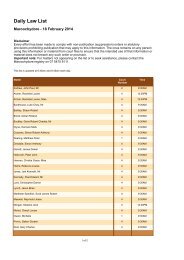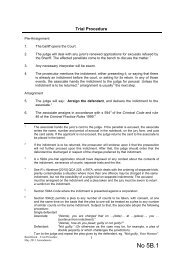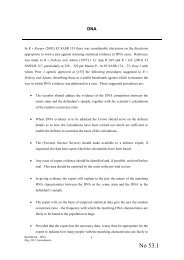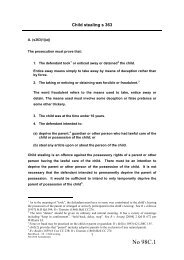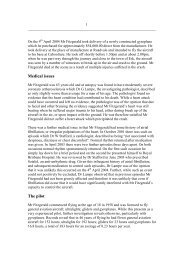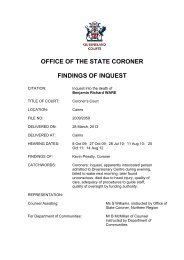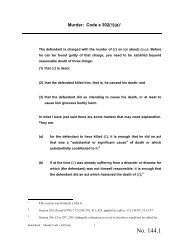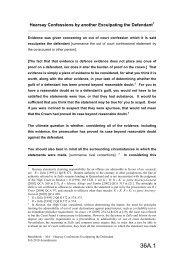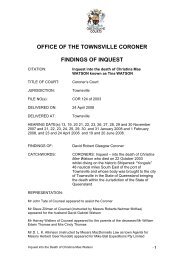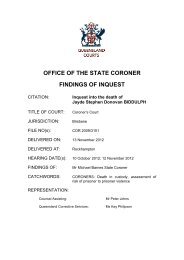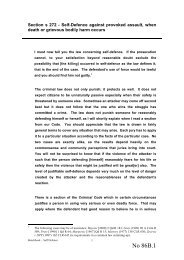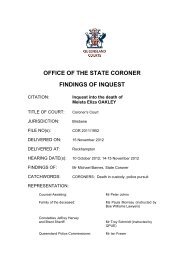Inquest findings - Rosly Amelia Law - Queensland Courts
Inquest findings - Rosly Amelia Law - Queensland Courts
Inquest findings - Rosly Amelia Law - Queensland Courts
You also want an ePaper? Increase the reach of your titles
YUMPU automatically turns print PDFs into web optimized ePapers that Google loves.
OFFICE OF THE STATE CORONER<br />
FINDINGS OF INQUEST<br />
CITATION: <strong>Inquest</strong> into the death of <strong>Rosly</strong>n <strong>Amelia</strong><br />
<strong>Law</strong><br />
TITLE OF COURT: Coroners Court<br />
JURISDICTION: Brisbane<br />
FILE NO(s): 2010/2524<br />
DELIVERED ON: 1 March 2012<br />
DELIVERED AT: Dalby<br />
HEARING DATE(s): 29 February 2012, 1 March 2012<br />
FINDINGS OF: Magistrate John Lock, Brisbane Coroner<br />
CATCHWORDS: Coroners: inquest, motor vehicle crash, cattle<br />
straying on rural roads, fencing & rule in Searle<br />
v Wallbank, impairment due to cannabis intake,<br />
blood tests policy<br />
REPRESENTATION:<br />
Counsel Assisting: Mr C Minnery, Office of the State Coroner<br />
Counsel for the Family: Mr C Greatorix, Solicitor<br />
Counsel for Mr L Henschell: Mr R Davies i/b Groom & Lavers<br />
Counsel for Sgt Stevenson: Mr T Schmidt i/b <strong>Queensland</strong> Police Union
Introduction<br />
1. On 21 July 2010, <strong>Rosly</strong>n <strong>Amelia</strong> <strong>Law</strong> was a front seat passenger in a<br />
sedan being driven by her de facto partner, Francis Ronald Maddigan.<br />
Her young daughter was in the rear driver-side of the vehicle. They were<br />
travelling along a rural road outside of Dalby at approximately 6:45pm<br />
when Mr Maddigan suddenly came upon a herd of cattle that had escaped<br />
from a nearby property. He was unable to avoid a collision with two of the<br />
cattle and as a result lost control of his vehicle that then collided with the<br />
rear end of a truck parked on the side of the road nearby. Other local<br />
residents travelling along the same road earlier had come across the herd<br />
of cattle and had stopped with the intention of moving them off the road.<br />
2. <strong>Rosly</strong>n suffered fatal head injuries and despite treatment died in Brisbane<br />
at the Princess Alexandra Hospital.<br />
3. The issues for the inquest were:<br />
(a) The matters required by section 45(2) Coroners Act 2003,<br />
namely who the deceased person was, how they died, when<br />
they died and what caused them to die;<br />
(b) The involvement of cattle that had strayed onto the highway<br />
in the cause of death of the deceased, including a<br />
consideration of whether the coroner may comment<br />
(pursuant to section 46 Coroners Act 2003) on wider<br />
circumstances such as ways to prevent similar deaths in<br />
future; and<br />
(c) The question of whether the driver of the vehicle the<br />
deceased was travelling in ought to be referred to the<br />
Director of Public Prosecutions or other agency pursuant to<br />
section 48 Coroners Act 2003<br />
The scope of the Coroner’s inquiry and <strong>findings</strong><br />
4. There has been considerable litigation concerning the extent of a<br />
coroner’s jurisdiction to inquire into the circumstances of a death. The<br />
authorities clearly establish that the scope of an inquest goes beyond<br />
merely establishing the medical cause of death.<br />
5. An inquest is not a trial between opposing parties but an inquiry into the<br />
death. In a leading English case it was described in this way:- “It is an<br />
inquisitorial process, a process of investigation quite unlike a criminal<br />
trial where the prosecutor accuses and the accused defends… The<br />
function of an inquest is to seek out and record as many of the facts<br />
concerning the death as the public interest requires.” 1<br />
6. The focus is on discovering what happened, not on ascribing guilt,<br />
attributing blame or apportioning liability. The purpose is to inform the<br />
1 R v South London Coroner; ex parte Thompson (1982) 126 S.J. 625<br />
Findings of the inquest into the death of <strong>Rosly</strong>n <strong>Amelia</strong> <strong>Law</strong> 1
family and the public of how the death occurred with a view to reducing<br />
the likelihood of similar deaths. As a result, the Act authorises a coroner<br />
to make preventive recommendations concerning public health or safety,<br />
the administration of justice or ways to prevent deaths from happening in<br />
similar circumstances in future. 2 However, a coroner must not include in<br />
the <strong>findings</strong> or any comments or recommendations, statements that a<br />
person is or maybe guilty of an offence or is or maybe civilly liable for<br />
something. 3<br />
The Admissibility of Evidence and the Standard of Proof<br />
7. Proceedings in a coroner’s court are not bound by the rules of evidence<br />
because the Act provides that the court “may inform itself in any way it<br />
considers appropriate.” 4 That does not mean that any and every piece<br />
of information however unreliable will be admitted into evidence and<br />
acted upon. However, it does give a coroner greater scope to receive<br />
information that may not be admissible in other proceedings and to have<br />
regard to its origin or source when determining what weight should be<br />
given to the information.<br />
8. This flexibility has been explained as a consequence of an inquest being<br />
a fact-finding exercise rather than a means of apportioning guilt. As<br />
already stated, it is an inquiry rather than a trial. If a witness refuses to<br />
give oral evidence at an inquest because the evidence would tend to<br />
incriminate the person, the coroner may require the witness to give<br />
evidence that would tend to incriminate the witness if satisfied it is in the<br />
public interest to do so. The evidence, when given, and any derivative<br />
evidence is not admissible against the witness in any other proceeding,<br />
other than a proceeding for perjury. 5<br />
9. A coroner should apply the civil standard of proof, namely the balance of<br />
probabilities but the approach referred to as the Briginshaw sliding scale<br />
is applicable. 6 This means that the more significant the issue to be<br />
determined, the more serious an allegation or the more inherently<br />
unlikely an occurrence, the clearer and more persuasive the evidence<br />
needed for the trier of fact to be sufficiently satisfied that it has been<br />
proven to the civil standard. 7<br />
10. It is also clear that a coroner is obliged to comply with the rules of<br />
natural justice and to act judicially. 8 This means that no <strong>findings</strong><br />
adverse to the interest of any party may be made without that party first<br />
being given a right to be heard in opposition to that finding. As Annetts v<br />
2<br />
s46<br />
3<br />
s45(5) and 46(3)<br />
4<br />
s37(1)<br />
5<br />
s39<br />
6<br />
Anderson v Blashki [1993] 2 VR 89 at 96 per Gobbo J<br />
7<br />
Briginshaw v Briginshaw (1938) 60 CLR 336 at 361 per Sir Owen Dixon J<br />
8<br />
Harmsworth v State Coroner [1989] VR 989 at 994 and see a useful discussion of the issue<br />
in Freckelton I., “<strong>Inquest</strong> <strong>Law</strong>” in The inquest handbook, Selby H., Federation Press, 1998 at<br />
13<br />
Findings of the inquest into the death of <strong>Rosly</strong>n <strong>Amelia</strong> <strong>Law</strong> 2
McCann 9 makes clear that includes being given an opportunity to make<br />
submissions against <strong>findings</strong> that might be damaging to the reputation of<br />
any individual or organisation.<br />
11. If, from information obtained at an inquest or during the investigation, a<br />
coroner reasonably suspects a person has committed a criminal offence,<br />
the coroner must give the information to the Director of Public<br />
Prosecutions in the case of an indictable offence, and to the chief<br />
executive of the department which administers legislation creating an<br />
offence which is not indictable. 10<br />
Social History<br />
12. Ms <strong>Rosly</strong>n <strong>Law</strong> was a 20 year old woman. Ms <strong>Law</strong> had a one-year-old<br />
daughter, Jenna Smith. She had been in a de-facto relationship with Mr<br />
Maddigan for approximately six to seven months. She lived in Quinalow<br />
with Mr Maddigan and her daughter. She was originally from Nelson<br />
Bay and had only fairly recently moved to the area.<br />
The Crash<br />
13. Mr Maddigan was driving a 1996 Mitsubishi Lancer sedan in an easterly<br />
direction on the Dalby-Cooyar Road approximately nine km east of the<br />
town of Kaimkillenbun. The Dalby-Cooyar Road is a sealed section of<br />
highway that runs approximately east west in orientation. 11 The road has<br />
one lane in each direction of travel separated by a single white broken<br />
centreline. The signed speed limit is 100km/hr. There is no system of<br />
street lighting. 12 At the area where the crash occurred there is a slight<br />
down grade of the road. 13<br />
14. The weather was reported to be fine and the road was dry at the time of<br />
the accident. 14 Mr Maddigan recalls it was dark and he had his lights on.<br />
He says it was clear at the time and it was not foggy. All other witnesses<br />
agree. The Main Roads Investigator reported that according to the<br />
Geoscience Australia website, Civil Twilight was estimated to have<br />
occurred at approximately 5.46pm on the afternoon of the accident. 15<br />
15. Mr Peter Swann and his wife Lucy lived on a five acre property along the<br />
Dalby-Cooyar Road. At approximately 6pm Peter Swann was driving<br />
home from Dalby with his wife along the same road. He was nearly<br />
home and had come over the hill just before his neighbour's property<br />
when he noticed there were cattle on the road. He went to his home and<br />
rang a friend and nearby neighbour, Kieran Lillis and asked him to come<br />
down and help him put the cattle back in the paddock. He then drove<br />
his truck back down to where the cattle were and found a section of<br />
9<br />
(1990) 65 ALJR 167 at 168<br />
10<br />
S 48(2)<br />
11<br />
Exhibit B1, p8<br />
12<br />
Exhibit B1, p8<br />
13<br />
Exhibit B1, p8<br />
14<br />
Exhibit B1, p8<br />
15<br />
Exhibit B2, p9<br />
Findings of the inquest into the death of <strong>Rosly</strong>n <strong>Amelia</strong> <strong>Law</strong> 3
fence that had fallen down. This property was owned by Mr Len<br />
Henschell.<br />
16. Mr Swann decided to park his truck near the hole in the fence and put on<br />
his parking lights and hazard lights. He deliberately did not put on his<br />
headlights, so that oncoming traffic was not blinded. There were orange<br />
lights on his mirrors. The weather was fine but given this was a rural<br />
road there was no street lighting and it was dark. There was no fog or<br />
dust around.<br />
17. Mr Swann parked his vehicle off to the left hand side of the road if you<br />
were travelling east and on a small angle with the tail of the truck slightly<br />
protruding onto the road. The road drops off towards the paddock in this<br />
area and he had a load of water on the back and felt he could not safely<br />
get in any further. Mr Swann said several vehicles were able to drive<br />
past his truck during the incident. His wife Lucy Swann had also come<br />
with him and had a torch and she was at the Quinalow end trying to get<br />
traffic to slow down.<br />
18. In the meantime his friend Kieran Lillis had brought his motorbike from<br />
his own property and was at the Dalby end. His bike had lights on and<br />
he was also trying to slow traffic down whilst Mr Swann tried to get the<br />
cattle back in the yard.<br />
19. Mr Swann states several motor vehicles made it through safely from both<br />
directions. He then saw a car coming from Dalby which did not appear to<br />
be going any faster than any other car which had travelled on the road.<br />
This was at the end where Kieran Lillis was with his motorbike. He then<br />
saw the car hit the cattle and then very quickly hit the rear of his truck.<br />
20. Mr Swann yelled out for his wife to call triple O and he ran up to the<br />
vehicle to see what he could do. He remembers Kieran also coming to<br />
the car to help. He could see that the roof of the car had been peeled<br />
right back. The driver of the car was very distraught and was yelling at<br />
his female passenger "don't leave me". He recalls the driver handing him<br />
a small child from the back of the car. The Fire Brigade and two<br />
ambulances arrived and after treatment took the injured persons away.<br />
21. Lucy Dawn Swann also confirms that she grabbed a torch and had<br />
walked back onto the road to try and slow traffic down and warn them<br />
about the cattle. A number of cars had driven past and she considered<br />
a couple went through too fast in the circumstances. She noticed Mr<br />
Lillis on his motorbike with the lights on and the truck parked on the side<br />
of the road with its hazard and parking lights on. She then suddenly<br />
heard a bang and turned around and saw a vehicle beside the truck.<br />
She went immediately back to her house nearby to call triple O and<br />
started a conversation but handed over to Mr Lillis.<br />
22. Kieran Lillis says he received a telephone call from Mr Swann asking for<br />
his assistance to move cattle off the road back into the Henschell's place<br />
Findings of the inquest into the death of <strong>Rosly</strong>n <strong>Amelia</strong> <strong>Law</strong> 4
23. He ran over to his neighbour’s residence and then went with him down<br />
to the road. His recollection was that Mr Swann’s truck was completely<br />
off the sealed section of the road at this time.<br />
24. They then all started to try and move cattle back towards the paddock.<br />
25. Mr Lillis states two motor vehicles came from the east and they tried to<br />
warn them but they did not slow and narrowly missed colliding with the<br />
cattle. As a result of this close call the cattle “spooked” and ran off in a<br />
westerly direction. He told the court at this time the cattle had been<br />
mustered to the edge of the gap in the fencing and were almost in when<br />
they were spooked. He decided to go back to his house and get his<br />
motorbike and rode past the cattle to stop them from going any further.<br />
26. Mr Lillis then parked his motorbike on the verge with the headlight still<br />
activated and started moving the cattle to the east. He then heard a car<br />
coming from the east and he ran back to his bike and turned it<br />
perpendicular to the road and waved his headlight across the road to<br />
warn the driver of the hazard. The vehicle, which he thought was<br />
travelling at the speed limit of 100kmh did not appear to be slowing and<br />
he tried to frenetically wave it down but it went straight past him and<br />
collided with the cattle which were on the sealed section of the road.<br />
27. The car then veered to its left and collided with the rear driver’s side<br />
corner of the truck tray.<br />
28. Mr Lillis told the court he was bewildered as to why the vehicle did not<br />
slow or the driver see him given what he was doing with his lights and<br />
then his hands as well as the lights of the truck ahead being on. He<br />
accepted the truck lights may have been obscured by the cattle. He<br />
estimates the truck was about 150 metres away from him and the<br />
nearest cattle were about 50 metres away.<br />
29. Mr Lillis went up to Mr Swann’s house and spoke with the triple O<br />
operator. He was given instructions to return to the crash scene and<br />
provide them with further information. His neighbour Jonathon Bigger<br />
who had first aid experience also arrived at the scene and said the<br />
condition of the lady was critical. He then went back to the house and<br />
provided information to triple O about the situation and directions to the<br />
crash location. He tried to use a hands free phone from the house at the<br />
scene without success. He then used someone’s mobile and continued<br />
to relay information that his friend was providing in relation to the<br />
condition of the occupant of the vehicle. He thought an ambulance took<br />
about 10 minutes to arrive and they then took control.<br />
30. The <strong>Queensland</strong> Ambulance Service records indicate a call was made at<br />
18:25 and the first ambulance was dispatched two minutes later and<br />
arrived at about 18:53. The statements and evidence of all witnesses<br />
and the transcript of the triple O call between ambulance operators and<br />
Findings of the inquest into the death of <strong>Rosly</strong>n <strong>Amelia</strong> <strong>Law</strong> 5
Mr Lillis indicate everyone at the scene provided the best possible care<br />
for all concerned including Ms <strong>Law</strong>. Mr and Mrs Swann and Mr Lillis<br />
should be commended for their actions in endeavouring to clear the<br />
cattle, warn other road users and provide comfort to the victims of the<br />
crash in what was a very upsetting situation. I also commend the actions<br />
of Mr Biggar who was the first person to arrive on the scene. He was<br />
instrumental in maintaining an airway and supporting Ms <strong>Law</strong>’s head<br />
until the <strong>Queensland</strong> Ambulance Service arrived.<br />
Evidence of Mr Maddigan<br />
31. Francis Ronald Maddigan was served with a letter from the Office of the<br />
State Coroner suggesting he obtain legal advice, given the likely<br />
evidence before the inquest could result in him being referred for<br />
prosecution. He did not do so but arrived at the inquest and requested a<br />
duty lawyer. Counsel Assisting, Mr Minnery made enquiries with the<br />
local duty lawyer who contacted Legal Aid but it became evident such<br />
services are not available in inquests.<br />
32. Mr Minnery also advised him of his right to refuse to answer questions if<br />
the answers may incriminate him subject to being required to do so by<br />
the court and given the protections provided as to their use in any later<br />
proceedings other than perjury. I similarly gave him the same<br />
information in court about s.39 of the Act. At no time did he claim<br />
privilege.<br />
33. Mr Maddigan’s evidence was to say the least, extraordinary. He made<br />
admissions about aspects of his behaviour that were damaging to him<br />
but clearly lied to the court about other matters that were not as<br />
important. At times in his evidence he was abusive and avoidant. His<br />
face was continually contorted in what was apparent rage, glaring at<br />
counsel who dared ask him some relevant questions or at myself. He<br />
punched the witness box. He was warned by me to behave himself but<br />
that enraged him further. He was treated appropriately and politely by all<br />
counsel but simply could not control himself.<br />
34. He said in his statement that he has had difficulty coping after the crash<br />
and is now on anti psychotic drugs. He stated he was seeing a<br />
counsellor and a psychiatrist. He is taking Zyprexa (olanzapine), which is<br />
used to treat schizophrenia and other psychoses including those that are<br />
drug induced and Bipolar Disorder. He takes alprazolam, which is used<br />
to treat anxiety.<br />
35. He told the court he had been a regular user of cannabis since he was<br />
aged 16. He told the court he used cannabis almost daily smoking<br />
between six to 12 cones. He used it to relax and calm him when angry.<br />
He denied that this level of cannabis use affects his driving capacity.<br />
36. A specimen of Mr Maddigan’s blood was required by police and taken at<br />
Dalby Hospital but was not analysed for drugs until this year. That<br />
analysis showed recent cannabis use. Mr Maddigan was then<br />
Findings of the inquest into the death of <strong>Rosly</strong>n <strong>Amelia</strong> <strong>Law</strong> 6
approached by police. He said in his most recent statement that he had<br />
smoked a couple of cones of cannabis an hour before driving. In court<br />
he said he had smoked five to six cones earlier in the day from around 4<br />
to 4.30. He disagreed with any suggestion this level would affect his<br />
reaction times or perception or negatively affect his ability to drive. He<br />
said it would help his concentration.<br />
37. Mr Maddigan said the cannabis he used that day was hydroponic and<br />
not bush cannabis. He gave a simply preposterous story that he had<br />
found the cannabis in a tobacco pouch down near the creek that day. He<br />
had a plastic bottle and by chance also found a piece of hose and<br />
fashioned a bong by tearing up some cans lying by for the cone piece.<br />
He said it was maybe 2 grams. He was reluctant to say anything about<br />
Ms <strong>Law</strong>’s use of cannabis on that day and this was not pressed. It was<br />
put to him he had some cannabis in the car with him at the crash and he<br />
angrily agreed. It was then put to him he took it with him to Dalby<br />
Hospital in the ambulance and then passed it on to his mother. He did<br />
not deny this, saying it was possible.<br />
38. Mr Maddigan was driving his own Mitsubishi Lancer with Ms <strong>Law</strong> in the<br />
front and her child Jenna in the back driver’s side seat. He was driving<br />
from Dalby to Quinalow to have dinner at his place. He had not been<br />
working that day and had been in town with Ms <strong>Law</strong>. He had also seen<br />
other people.<br />
39. He stated he was driving at approximately 100 km/h, a speed he always<br />
drives at as it is the speed limit. He was unable to concede that given it<br />
was dark, in the middle of winter on a country road with possible cattle<br />
around, that precautions such as lowering the speed should be<br />
considered. He worked on a dairy property and was experienced in the<br />
behaviour of cattle including they can be spooked by traffic if they are on<br />
a road. He had driven down this road many times.<br />
40. He remembers coming over the hill and dipped his lights because he<br />
saw what looked like a motorbike on the left-hand side of the road in the<br />
paddock. He said in court he thought someone was looking at the fence.<br />
He clearly did not slow down at this time. He agreed that if there was a<br />
hazard ahead a driver should slow down. He says he did not see Mr<br />
Lillis waving at him or any hazard lights on a truck.<br />
41. He then saw eyes in his car lights straight in front of him, guessed it was<br />
a cow but was unable to avoid it and hit it with the front end of his car.<br />
His car seemed to pull to the left. He then saw another cow and he<br />
turned to the right to avoid it but hit it as well. He had applied the brakes<br />
really hard by this time and then saw the truck. He does not recall any<br />
lights on the back of it. He was braking hard, turning and sliding and<br />
then hit the back of the truck. He said he was not distracted by anything<br />
and was not tired at the time.<br />
Findings of the inquest into the death of <strong>Rosly</strong>n <strong>Amelia</strong> <strong>Law</strong> 7
42. He told police he had not had a drink of alcohol in the previous 24 hours<br />
before the crash. A specimen of his blood was requested at Dalby<br />
Hospital and an analysis confirmed this. He did not volunteer to police<br />
when he gave a later statement that he had smoked cannabis. It was not<br />
until my office requested the blood be tested for drugs that the cannabis<br />
was detected.<br />
Escaped Cattle and Wild Dogs<br />
43. Mr Leonard Henschell has owned the property adjacent to where the<br />
crash occurred for approximately 16 years. He states he has replaced<br />
the fences over the years with five strand barbed wire with split posts.<br />
The section where the cattle escaped on this occasion had not been<br />
replaced as he had run out of money. He says he does not put cattle in<br />
the front paddock at this time.<br />
44. He believed the cattle were pushed through the fence by wild dogs that<br />
were seen in the area around that time. He was given information by<br />
Max Dorge that wild dogs had been seen in the area. He does not reside<br />
on the property but lives in the town of Oakey and visits the property at<br />
least four days a week.<br />
45. He said in his statements that prior to this crash he was not aware his<br />
cattle had ever escaped from the property. He has received no<br />
complaints of any escape of his cattle nor have any of his cattle been<br />
involved in any motor vehicle accidents. In evidence he agreed there<br />
was an incident years ago when a cow was hit by a slow moving vehicle<br />
when there was smoke across the road. He only recalls one telephone<br />
call from Mr Swann about cattle on the road. He agreed that on one<br />
occasion he gave a gift of fish and waygu steaks to Mr and Mrs Swann<br />
to thank them for helping out with stray cattle.<br />
46. Mr Darren Henschell (Mr Len Henschell’s son) stated he was at the<br />
property on the day in question and the cattle were checked at about<br />
3:30 to 4pm on the day of the crash. He says this was to ensure they<br />
had oats for feed, and water. He says he then went into town to meet Mr<br />
Lindsay Vonoff. 16<br />
47. He further stated that when going home at 4:30pm, he was looking up<br />
and down the highway checking for cars. He saw no cattle on the road at<br />
the time. When he pulled in to home Mr Darren Henschell was told by<br />
his mother to go back up to the farm as there were cattle on the<br />
highway. He says he headed straight back with his father and this would<br />
have been after 7.15 to 7.30.<br />
48. Mr Len Henschell has confirmed on the day of the accident he received<br />
a phone call from Mr Swann advising cattle had escaped. He says he<br />
advised Mr Swann to leave the cattle where they were and he and his<br />
16 Exhibit C2, p1<br />
Findings of the inquest into the death of <strong>Rosly</strong>n <strong>Amelia</strong> <strong>Law</strong> 8
son would go to the farm to sort the situation out as quickly as they<br />
could. 17<br />
49. It is apparent Mr Henschell senior has some of his times mixed up but it<br />
is evident he was told about the stray cattle before the crash occurred<br />
and did not know of it until they arrived.<br />
50. Mr Swann stated he had to put cattle back on previous occasions when<br />
they had been in the front paddock and knows of previous crashes<br />
involving Mr Henschell's cattle on the same road.<br />
51. Mr Swann states he was aware of three previous crashes involving Mr<br />
Henschell’s cattle. He was not home for two of them but was present for<br />
one approximately four years previously. The driver in that crash was<br />
not hurt but the car was towed away. He recalls telephoning Mr<br />
Henschell informing him that his cattle were out but he did not come out<br />
immediately to repair the fence or put his cattle back in the yard so Mr<br />
Swann had to put them back into the paddock in the morning.<br />
52. Lucy Dawn Swann also confirms her knowledge of three previous<br />
crashes and that she or her husband would have contacted Mr<br />
Henschell by telephone when his cattle have been out. He had not<br />
always come out to put the cattle back in and her husband has had to<br />
put them back sometimes.<br />
53. Mr Swann stated in court that the cattle had strayed many times over the<br />
years and almost always he simply put them back into the property and<br />
replaced the gate that had fallen over or did some minor repairs to<br />
fencing. He did not ring the Henschells complaining about this other than<br />
on two to three occasions.<br />
54. Mr and Mrs Swann also stated that in relation to this particular incident<br />
they did not hear of any reports about wild dogs chasing cattle and were<br />
not aware of any reports of wild dogs in the area.<br />
55. Mr Lillis recalls there have been times in the past where cattle have<br />
been able to gain access to the road. Over 15 years ago he recalled an<br />
incident involving the Henschell’s cattle and a vehicle with the SES and<br />
police involved. He had been told by Mr Swann of other occasions when<br />
Mr Swann has put cattle back.<br />
56. The issue of wild dogs apparently comes from a discussion Lloyd Klein<br />
had with Max Dorge. Mr Klein does not know Mr Henschell or any of the<br />
persons involved in the crash. He also has a property located on the<br />
Dalby-Cooyar Road closer to Kaimkillenbun than the crash site. He<br />
says on 22 July 2010 he had some cattle push through his own fence<br />
and into a neighbour's property. He saw a number of wild dogs on his<br />
17 Exhibit C8, p1<br />
Findings of the inquest into the death of <strong>Rosly</strong>n <strong>Amelia</strong> <strong>Law</strong> 9
property that day and the next day he shot two young wild dogs. He<br />
related this information to Mr Dorge who then spoke to Mr Henschell.<br />
57. The Western Downs Regional Council was requested to provide any<br />
information relating to wandering livestock along the Dalby Cooyar<br />
Road. It was only aware of one report where it was called to remove<br />
livestock from the road approximately four years previously. There have<br />
been no local prosecutions in relation to escaping livestock or fencing<br />
requirements. In general a stock proof fence fit for the type of livestock<br />
kept is generally required for such properties.<br />
58. The Department of Main Roads has no recorded history of livestock<br />
strikes on the Dalby-Cooyar Road in the previous five years.<br />
59. I accept the evidence of Mr and Mrs Swann that there have been a<br />
number of occasions over the years where cattle strayed from the<br />
property, particularly when they were in the front paddock. I accept it<br />
could not be quite to the extent of the numerous occasions described in<br />
a general way by Mr Swann, but it was a common if not frequent event.<br />
There were other incidents involving vehicles but it would seem only a<br />
couple. All of this was spread over a number of years.<br />
60. This is not inconsistent with Mr Leonard Henschell’s evidence given that<br />
it is agreed Mr and Mrs Swann made no complaints or informed the<br />
Henschells other than on a couple of times. They were simply being<br />
good neighbours and given the Henschells lived some distance away<br />
and the inherent danger of leaving cattle straying on the road, they took<br />
steps. I accept the Swann’s contacted the Henschells more than once<br />
but clearly they may have spoken to Mrs Henschell.<br />
61. I accept both families provided honest evidence to the best of their<br />
recollections.<br />
62. I do not accept there is sufficient evidence to suggest wild dogs played a<br />
part, although that cannot be absolutely excluded.<br />
Condition of the Fence<br />
63. Mr Darren Henschell reported seeing on his arrival at the accident scene,<br />
the fence busted with a wooden post snapped off at the ground, and in<br />
another place a steel star picket bent right over. 18 He says the wooden<br />
post was lying on the ground towards the highway. 19<br />
64. Mr Len Henschell says on his arrival at the accident scene he found a<br />
wooden fence post on the side boundary of his property had snapped off<br />
at the ground, and in another place a steel star picket was bent right<br />
over. 20 He says the wooden post was lying on the ground towards the<br />
18 Exhibit C2, p2<br />
19 Exhibit C2, p2<br />
20 Exhibit C8, p1<br />
Findings of the inquest into the death of <strong>Rosly</strong>n <strong>Amelia</strong> <strong>Law</strong> 10
highway. 21 He reports the cattle had been put back in the paddock and<br />
they made temporary repairs to the fence. 22 He says the fencing was<br />
pretty good generally.<br />
65. Mr Swann reports the fence posts were in the condition as described by<br />
the Henschells and photographs were tendered which show the repairs.<br />
66. After the accident on 12 August 2010, the Main Roads Investigator<br />
found the fencing to be in a reasonable condition and of an appropriate<br />
construction for retaining cattle. He observed the fence posts on the<br />
southern fence line to have a slight lean toward the road. 23<br />
67. Mr Swann agrees the fencing on the Henschell’s property is better than<br />
most neighbouring properties.<br />
68. Even accepting the varying opinions that the fencing was considered<br />
reasonable for its purpose, it may not be coincidence that the one part of<br />
the fencing which had not been replaced on the property was that<br />
adjoining the main road. In accepting the Swann’s evidence that cattle<br />
had strayed on a number of occasions in the past, it is evident there may<br />
have been issues concerning the condition of the fencing that could<br />
have been better addressed. However, that aside, the evidence could<br />
not support a finding the fencing was inadequate, and as Mr Davies<br />
submitted, the evidence before the court suggests it was reasonable for<br />
its purpose. I accept the Henschells were not aware of the extent of the<br />
frequency of the straying cattle and have since taken the sensible<br />
precaution of not having cattle in the front paddock.<br />
69. I will discuss the issue of the immunity for liability of landowners for<br />
straying cattle shortly. This case and others highlights the inherent<br />
danger to road users of straying cattle and perhaps a change to the law<br />
is warranted given this may give some incentive for landowners to<br />
ensure fencing adjoining roadways is suitable to keep cattle off the road.<br />
Blood Alcohol and Drugs Testing<br />
70. Mr Maddigan provided a blood sample at 8.37pm on 21 July 2010 at<br />
Dalby Hospital as directed by Constable Jessica Huth. This was<br />
analysed on 26 July 2010 and was negative for the presence of alcohol.<br />
71. Constable Huth stated it was QPS policy to test drivers involved in traffic<br />
crashes for alcohol. She stated Mr Maddigan otherwise displayed no<br />
indicia of being intoxicated or being affected by drugs and she therefore<br />
had no reasonable suspicion to test him for drugs.<br />
21 Exhibit C8, p1<br />
22 Exhibit C8, p1<br />
23 Exhibit B2, p7<br />
Findings of the inquest into the death of <strong>Rosly</strong>n <strong>Amelia</strong> <strong>Law</strong> 11
72. A drug analysis was therefore not performed until the coroner requested<br />
it and this was performed about 16 months later. This showed the<br />
presence of cannabis as follows: –<br />
∆9 – tetrahydrocannabinol (THC) 0.003mg/kg<br />
11-nor-∆9 –terahydrocannabinnol-9-carboxylic acid 0.090mg/kg<br />
73. Dr Robert David Hoskins, Director of the Clinical Forensic Medicine Unit<br />
opined that generally a level of this nature would indicate use within the<br />
preceding 24 hours.<br />
74. Mr Maddigan was asked by police about his use of cannabis. He told<br />
them in a written statement 24 that he had been smoking cannabis since<br />
he was about 15 or 16 years. He used it to deal with issues concerning<br />
depression. Prior to the crash he stated he would have had a couple of<br />
cones about one hour before leaving town in the motor vehicle. He did<br />
not think he was affected by the cones whilst he was driving.<br />
75. Combined with the analysis results and the statement by Mr Maddigan,<br />
Dr Hoskins considered the levels detected make it highly probable Mr<br />
Maddigan's driving would have been impaired regardless of his<br />
subjective opinion that it was not. Impairment due to cannabis persists<br />
beyond the subjective high and the latter would normally persist for two<br />
to three hours.<br />
76. Dr Hoskins stated that testing some 16 months later was not desirable<br />
but any delay would not have produced an inflated reading and if<br />
anything it would be less than if tested earlier.<br />
77. Dr Hoskins could not say with any degree of certainty how a level of<br />
0.003 would subjectively affect a person but he could say it was a<br />
significant level indicating recent use. Levels of 0.007 to 0.01 are<br />
generally the levels where it could be said a person would certainly be<br />
affected but a lower level does not exclude impairment.<br />
78. On the evidence from Mr Maddigan, Dr Hoskins thought a person taking<br />
five to six cones an hour or two before driving was highly probably<br />
impaired but this may not reach the criminal standard of proof.<br />
Impairment included slower reaction times and poorer concentration in a<br />
person compared to what would be their normal subjective state.<br />
79. Given Mr Maddigan’s evidence I suspect this was his permanent state.<br />
80. Dr Hoskins also gives evidence about the current policy regarding the<br />
testing of drivers involved in fatal crashes. There has been comment in<br />
other coronial <strong>findings</strong> that there should be full alcohol and drug testing<br />
of all drivers and pedestrians fatally injured in traffic crashes. He stated<br />
it seems incongruous that a similar policy does not exist in relation to the<br />
24 Exhibit C1.1<br />
Findings of the inquest into the death of <strong>Rosly</strong>n <strong>Amelia</strong> <strong>Law</strong> 12
testing of potentially culpable surviving drivers. Mr Schmidt, counsel<br />
representing Sgt Stevenson makes a similar submission.<br />
81. Sgt Stevenson gave evidence that to his knowledge there is no<br />
<strong>Queensland</strong> Police Service (QPS) policy to routinely drug test potentially<br />
culpable drivers involved in serious crash incidents.<br />
82. I will be making a recommendation to the effect there should be full<br />
alcohol and drug testing of all potentially culpable surviving drivers<br />
involved in motor vehicle crashes where someone is seriously injured or<br />
killed.<br />
Injuries to Ms <strong>Law</strong>, Treatment and Autopsy results<br />
83. The <strong>Queensland</strong> Fire and Rescue Service (QFRS), the <strong>Queensland</strong><br />
Ambulance Service (QAS), and the QPS attended the scene. Ms <strong>Law</strong>,<br />
her daughter and Mr Maddigan were all transferred from the accident<br />
site by QAS to the Dalby Hospital.<br />
84. Ms <strong>Law</strong> was transferred by helicopter to the Princess Alexandra<br />
Hospital. She had a severe head injury with a Glasgow coma score of<br />
three with fixed dilated pupils. A CT scan of her head found a diffuse<br />
axonal injury, traumatic subarachnoid haemorrhage, intraventricular<br />
haemorrhage, a number of facial fractures and scalp and facial<br />
abrasions. No neurological intervention was possible and she<br />
developed severe cardiogenic shock, likely due to stress<br />
cardiomyopathy based on echocardiography <strong>findings</strong> and multiorgan<br />
failure. Her overall condition continued to deteriorate despite aggressive<br />
therapy, mechanical ventilation and other treatment. After a discussion<br />
with her family as to the futility of her condition, treatment was withdrawn<br />
and she died in the afternoon of 23 July 2010.<br />
85. The cause of death was due to a severe head injury and multiorgan<br />
failure as a result of the injuries sustained in the motor vehicle accident.<br />
86. An external and partial examination by way of autopsy was ordered. In<br />
particular an examination of the heart was ordered to verify the presence<br />
of stress cardiomyopathy.<br />
87. The autopsy examination supported by a CT scan confirmed the<br />
presence of severe head injuries. An examination of the heart showed<br />
changes consistent with a diagnosis of stress cardiomyopathy with no<br />
evidence of pre-existing heart disease. The cardiac condition may well<br />
have hastened her death but the head injuries were unsurvivable.<br />
88. An examination of a blood sample taken within two hours of the accident<br />
and prior to transfer to Brisbane showed the presence of therapeutic<br />
amounts of midazolam and morphine which were likely to have been<br />
administered in the course of emergency care. No alcohol was detected<br />
but there were significant levels of the active ingredient of cannabis<br />
(0.009) and its main metabolite.<br />
Findings of the inquest into the death of <strong>Rosly</strong>n <strong>Amelia</strong> <strong>Law</strong> 13
Collision Analysis Findings<br />
89. The Forensic Crash Unit at Dalby investigated the crash and provided a<br />
collision analysis report 25 to the coroner. Sgt Brett Stevenson was the<br />
investigator. Statements were taken from relevant witnesses.<br />
Photographs of the crash scene were taken as well as a forensic<br />
analysis of other scene evidence including skid testing results, a forensic<br />
map of the same, and a mechanical inspection of both vehicles.<br />
90. There was some criticism of the timeliness of the production of the<br />
Collision Analysis Report to the coroner and more particularly of the time<br />
it took for Mr Maddigan to be approached to give a statement. Sgt<br />
Stevenson obviously had a number of other duties as Officer in Charge<br />
of the Dalby Traffic Branch, which may have impacted on his capacity to<br />
produce the report earlier. I accept that as being the case and<br />
personally have no criticism of the timeliness of the production of the<br />
report, it being within the range of reasonable expectations given the<br />
complexity of some investigations.<br />
91. Leaving aside the issue of drug testing, I also consider that otherwise<br />
the quality of the investigation was well up to an appropriate professional<br />
standard.<br />
92. The Department of Main Roads also conducted a Crash Investigation<br />
and provided a report. 26 Mr Ben Gesch from the Department was<br />
assigned to investigate the accident. He undertook an initial site<br />
inspection on 27 July 2010 and a full site inspection on 12 August<br />
2010. 27<br />
93. Mr Gesch concluded that no remedial works were required to the road or<br />
surrounding infrastructure as a result of the crash.<br />
94. A police mechanic inspected the Mitsubishi sedan and found defects to<br />
the vehicle which would place it in an unsatisfactory condition, but none<br />
of these defects contributed to the crash.<br />
95. The Mitsubishi sedan was extensively damaged. The impact with the<br />
cows caused the bonnet skin to become detached from its frame.<br />
96. The impact with the rear of the truck caused the roof area around the<br />
front passenger compartment to sustain extensive damage and caused<br />
the injuries to Ms <strong>Law</strong>.<br />
97. The truck sustained impact damage to the rear driver-side underneath<br />
the tray. A police mechanic inspection of the truck found it also had<br />
defects which placed it in an unsatisfactory condition but given it was<br />
stationary at the time those defects could not have contributed to the<br />
25 Exhibit B1<br />
26 Exhibit B2<br />
27 Exhibit B2, p6<br />
Findings of the inquest into the death of <strong>Rosly</strong>n <strong>Amelia</strong> <strong>Law</strong> 14
crash. An inspection of the rear taillights and hazard lights found<br />
evidence these lights were operational and were on at the time of the<br />
crash.<br />
98. The forensic report concluded the Mitsubishi sedan was travelling in an<br />
easterly direction at the time of impact. There is no contention the<br />
vehicle struck two cows prior to striking the rear of the unoccupied truck<br />
parked on the side of the road.<br />
99. The original area of impact with the first cow was able to be located<br />
due to cow faeces and two gouge marks made by the front passenger<br />
side of the Mitsubishi.<br />
100. The second area of impact with the second cow was not as clear<br />
however the investigator believed it could be inferred it occurred while<br />
the Mitsubishi was half off the sealed surface and swerving back to the<br />
right prior to striking the truck.<br />
101. The third area of impact was at the location where the Mitsubishi has<br />
hit the rear of the truck which was about 2.2m from the rear of the final<br />
resting position of the truck.<br />
102. Due to gouge marks at the location of the first contact with the cow it<br />
is believed the front passenger wheel assembly of the Mitsubishi<br />
collapsed and this is evidenced by the tyre marks left on the gravel<br />
shortly after this impact.<br />
103. It was the view of the investigator that Mr Maddigan would not have<br />
had control of the vehicle after this point.<br />
104. Skid marks evidence indicates the Mitsubishi was back on the road at<br />
the time of the impact with the truck and there is evidence the rear of<br />
the truck was slightly hanging back over the sealed section of the road.<br />
105. An analysis of the speed of the Mitsubishi was difficult to determine<br />
due to the impact with the two cows. The impact with the rear of the<br />
Daihatsu was also considered to be more a glancing blow than a<br />
genuine rear end impact.<br />
106. The distance between where the Mitsubishi slid to a stop and the first<br />
impact with the cow was 55m and on that basis the report considered<br />
the Mitsubishi would be only doing 100km/h when colliding with the first<br />
cow.<br />
107. There was evidence that 100% braking was not used throughout<br />
most of the incident and that the vehicle also went onto the gravel<br />
surface. Both of those factors would lower the speed of the Mitsubishi<br />
entering the scene. There is no evidence from witnesses that they<br />
thought the Mitsubishi was speeding. It was believed it was more likely<br />
Findings of the inquest into the death of <strong>Rosly</strong>n <strong>Amelia</strong> <strong>Law</strong> 15
than not that Mr Maddigan was on or around the speed limit of 100km/h<br />
at the time of the crash.<br />
108. Due to the damage to the front wheel assembly of the Mitsubishi the<br />
investigator considered Mr Maddigan would not have had enough<br />
control over the vehicle to swerve to avoid the collision.<br />
109. The investigator then considered the question of avoiding the cattle<br />
and braking to a stop in the first place. The distance between the initial<br />
impact with the first cow to the impact with the truck was about 45m.<br />
The distance from the initial impact with the cow to the beginning of the<br />
skid marks is about 30m.<br />
110. The length of the crash scene is about 45m long which would take<br />
1.62 seconds to cover this distance at 100km/h. The distance from the<br />
impact point to the start of skid marks is about 30m which would take<br />
about 1.08 seconds to cover at 100km/h. and to react in about 1.08<br />
seconds the investigator considered the driver of the vehicle would<br />
have had to have better than average reflexes or have been expecting<br />
the impact to occur.<br />
111. Sgt Stevenson opined that taking average perception reaction times<br />
in rural areas at about 1.4 to 2 seconds, the speed of the Mitsubishi<br />
may have been actually slower than 100km/h as the time the brakes<br />
were applied relative to 100km/hr is 1.08 seconds.<br />
112. It was the opinion of Sgt Stevenson that Mr Maddigan had no criminal<br />
liability in respect to his actions on the night. He concluded that “Taking<br />
into account all of the circumstances I believe MADDIGAN has acted<br />
as any ordinary person would have in the same circumstances and that<br />
after striking the cattle no longer had control over the situation. I do not<br />
believe that there is any evidence of MADDIGAN having driven in any<br />
other way other than that of the ordinary person leading up to the<br />
crash.” 28<br />
113. What the forensic collision analysis does not take into account is the<br />
level of impairment in the driving capability of Mr Maddigan due to his<br />
intake of cannabis in the hours before getting behind the wheel.<br />
114. There is no doubt in my mind that it was highly probable Mr<br />
Maddigan’s reaction times, perception and concentration were impaired<br />
by recent cannabis use. It perhaps explains why Mr Maddigan did not<br />
slow the vehicle as he approached the area and saw lights ahead. It<br />
may explain why he did not see Mr Lillis wildly waving at him or why he<br />
says he saw no hazard lights.<br />
28 Exhibit B1, p25<br />
Findings of the inquest into the death of <strong>Rosly</strong>n <strong>Amelia</strong> <strong>Law</strong> 16
Conclusions<br />
Findings required by s45<br />
Identity of the deceased – <strong>Rosly</strong>n <strong>Amelia</strong> <strong>Law</strong><br />
How she died – <strong>Rosly</strong>n was a front seat passenger in a motor<br />
vehicle driven by her defacto Francis Ronald<br />
Maddigan driving along the Dalby-Cooyar<br />
Road which came into collision with two<br />
escaped cows from a rural property adjoining<br />
the road through a hole in fencing. As a result<br />
of the collision with the cows the driver lost<br />
control of his motor vehicle and came into<br />
collision with the rear tray of a truck which had<br />
been stationary on the side of the road.<br />
Although he was probably not speeding the<br />
driver would have had an impaired driving<br />
capacity due to recent intake of cannabis which<br />
may have been contributory to him not seeing<br />
or reacting sufficiently to the warnings being<br />
given about the dangers of the cattle ahead.<br />
Place of death – The Princess Alexandra Hospital<br />
Woolloongabba Qld 4102<br />
Date of death– 23 July 2010<br />
Cause of death – 1(a). Head injuries<br />
1(b). Motor vehicle accident (passenger)<br />
Comments and recommendations<br />
Exercise of discretion of the Coroner to refer any party in<br />
accordance with s 48(2)<br />
115. Section 48(2) of the Act gives a coroner discretion to give information<br />
to the Director of Public Prosecutions if the coroner reasonably suspects<br />
a person has committed an indictable offence.<br />
116. The relevant criminal offence in the circumstances of <strong>Rosly</strong>n <strong>Law</strong>’s<br />
death to be considered is s328A of the Criminal Code Act 1899<br />
‘Dangerous operation of a vehicle’.<br />
117. Section 328(4) of the Criminal Code Act 1899 states:<br />
A person who operates, or in any way interferes with the operation of, a<br />
vehicle dangerously in any place and causes the death of or grievous<br />
bodily harm to another person commits a crime and is liable on<br />
conviction on indictment –<br />
Findings of the inquest into the death of <strong>Rosly</strong>n <strong>Amelia</strong> <strong>Law</strong> 17
(a) to imprisonment for 10 years, if neither paragraph (b) nor (c)<br />
applies; or<br />
(b) to imprisonment for 14 years if, at the time of committing the<br />
offence, the offender is –<br />
(i) adversely affected by an intoxicating substance; or<br />
(ii) excessively speeding; or<br />
(iii) taking part in an unlawful race or unknown speed<br />
trial; or<br />
(c) to imprisonment for 14 years, if the offender knows, or ought<br />
reasonably know the other person has been killed or injured,<br />
and the offender leaves the scene of the incident, other than to<br />
obtain medical or other help for the other person before a police<br />
officer arrives.<br />
118. The term ‘operates, or in any way interferes with the operation of, a<br />
vehicle dangerously’ means operate, or in any way interfere with the<br />
operation of, a vehicle at a speed or in a way that is dangerous to the<br />
public, having regard to all the circumstances, including:<br />
(a) the nature, condition and use of the place; and<br />
(b) the nature and condition of the vehicle; and<br />
(c) the number of persons, vehicles or other objects that are, or<br />
might reasonably be expected to be, in the place; and<br />
(d) the concentration of alcohol in the operator’s blood or breath;<br />
and<br />
(e) the presence of any other substance in the operator’s body.<br />
119. The elements of the offence are, the accused:<br />
(1) operated, or in any way interfered with the operation of, a vehicle;<br />
(2) dangerously;<br />
(3) in any place; and<br />
(4) caused the death of or grievous bodily harm to another person.<br />
120. The circumstances of aggravation are:<br />
(1) whilst adversely affected by intoxicating substance; or<br />
(2) whilst excessively speeding; or<br />
(3) whilst taking part in an unlawful race or unlawful speed trial; or<br />
(4) knowing, or ought reasonably to have known, the other person had<br />
been killed or injured, left the scene of the incident other than to<br />
obtain medical or other help for the other person before a police<br />
officer arrives.<br />
121. An offence of dangerous driving does not require proof of criminal<br />
negligence. 29 The proper test to be applied in the case of dangerous<br />
29 R v Wilson [1965] QWN 42<br />
Findings of the inquest into the death of <strong>Rosly</strong>n <strong>Amelia</strong> <strong>Law</strong> 18
driving is an objective test. 30 That is, the accused person’s mind is not<br />
relevant. It is whether in all the circumstances the driving was in fact<br />
dangerous. 31 Further, there must be some fault on the part of the driver<br />
which caused that danger to the public. 32<br />
122. Fault is described as involving “a failure, a falling below the care or skill<br />
of a confident, experienced driver in relation to the manner of the driving<br />
and the relevant circumstances of the case”. 33<br />
123. The threshold for referral provided for in s48(2) of the Act is reasonably<br />
low and I only need to reasonably suspect a person has committed an<br />
indictable offence.<br />
124. After considering the evidence raised in this case carefully I have<br />
determined this is a case where such a referral should not be made. It is<br />
clear from the evidence of Dr Hoskins there is insufficient evidence at<br />
the criminal standard of proof to find that Mr Maddigan was beyond<br />
reasonable doubt impaired by cannabis use. The level analysed is not<br />
sufficient on its own to make such a finding and there is no evidence of<br />
other indicia to support such a finding beyond reasonable doubt. The<br />
manner of driving is certainly one which on one view, may be considered<br />
imprudent, but given the evidence from the forensic investigation and the<br />
evidence of near misses by other drivers that night in similar<br />
circumstances, the manner of driving on its own is not sufficient to<br />
support a referral.<br />
125. What is clear is that based on the evidence of Mr Maddigan alone, and<br />
in combination with the drug analysis results he may have committed an<br />
offence under s79 (1) of driving under the influence of cannabis or was a<br />
person who has breached s 79 (2AA) of the Transport Operations (Road<br />
Use Management) Act 1995 (TORUM) in that he was a person who<br />
while a relevant drug was present in his blood or saliva drove a motor<br />
vehicle. It is apparent any referral for that offence could be to the Chief<br />
Executive of <strong>Queensland</strong> Transport, which administers TORUM, or to<br />
the <strong>Queensland</strong> Police Service, which prosecutes such offences under<br />
TORUM. As Mr Schmidt points out in his submissions there are statute<br />
of limitations issues that come into play but there is still time to<br />
commence those proceedings should that be considered appropriate.<br />
126. Accordingly, I refer the matter of Mr Maddigan’s conduct to the<br />
<strong>Queensland</strong> Police Service, for consideration as to the possibility that he<br />
has committed an offence against s.79(1) and/or s.70(2AA) of the<br />
Transport Operations (Road Use Management) Act 1995.<br />
30 R v McBride [1962] 2 QB 167<br />
31 R v Ball and Loughhlin (1966) 50 CR App R 266<br />
32 R v Webb [1986] 2 Qd R 446<br />
33 R v Webb [1986] 2 Qd R at 450<br />
Findings of the inquest into the death of <strong>Rosly</strong>n <strong>Amelia</strong> <strong>Law</strong> 19
Livestock Straying on Highways: Civil Liability for Damages<br />
127. The law in <strong>Queensland</strong> as it presently stands is that owners or<br />
occupiers of land adjoining a highway are under no legal obligation to<br />
fence or to maintain their fences along the highway so as to prevent their<br />
animals from straying onto the highway, nor are they under a duty as<br />
between themselves and the users of the highway to take reasonable<br />
care to prevent any of their animals, not known to be dangerous, from<br />
straying onto the highway.<br />
128. This law, known as the rule in Searle v Wallbank is based on an old<br />
English common law rule which has now been abolished by statute in<br />
England and in most Australian jurisdictions, but not in <strong>Queensland</strong> or<br />
the Northern Territory. As indicated in the research paper which forms<br />
part of the brief of evidence 34 the continued applicability of the rule was<br />
confirmed in a decision of the <strong>Queensland</strong> Court of Appeal as late as in<br />
2006.<br />
129. The issue was considered by the <strong>Queensland</strong> <strong>Law</strong> Reform<br />
Commission (QLRC) in a working paper in 1977 35 which advocated that<br />
the rule be abolished; concluded that the legal liability for animals should<br />
be left to the general law of negligence and recommended the<br />
enactment of a draft bill. The recommendations of the QLRC have not<br />
been implemented.<br />
130. In a response to a request from my office as to information regarding<br />
the status of the Government's consideration of any legislative change in<br />
response to the QLRC recommendations, the Director-General of the<br />
Department of Justice and Attorney-General advised 36 that it was<br />
currently undertaking a review of the continued application of the rule.<br />
Subject to the views of any incoming government the next stage of the<br />
review would involve consultation with relevant government agencies,<br />
insurers, rural representatives, local government and legal stakeholders.<br />
131. The letter said issues that would need to be considered as part of the<br />
review included financial impacts on rural and agricultural stakeholders;<br />
insurance impacts; road signage regimes; the treatment of stock routes<br />
and the interface of any proposals with existing state legislation and the<br />
common law framework generally.<br />
132. It was submitted, and I agree, that the language and generality of the<br />
response from the Department does not promote any confidence that<br />
anything has been done since 1977 or is likely to be done in the<br />
foreseeable future.<br />
133. The circumstances relating to this inquest in my view clearly brings into<br />
question the continued applicability of this archaic immunity from liability.<br />
34<br />
Exhibit H1 <strong>Queensland</strong> Parliamentary Library e-Research Brief 2010/10<br />
35<br />
Civil Liability for Animals, QLRC WP 18<br />
36<br />
Exhibit H3<br />
Findings of the inquest into the death of <strong>Rosly</strong>n <strong>Amelia</strong> <strong>Law</strong> 20
Given this issue has not been considered by the QLRC since 1977, and<br />
given there are a number of complex issues that need consideration, it<br />
may be the QLRC is best placed to advise Government on the matter.<br />
134. It is recommended the <strong>Queensland</strong> <strong>Law</strong> Reform Commission<br />
review its recommendations of the 1977 working paper concerning<br />
the abolition or retention of the rule in Searle v Wallbank with<br />
respect to the civil liability of owners or occupiers for damage<br />
caused by animals straying upon highways and what should be put<br />
in its place, and otherwise make such recommendations for change<br />
as it considers appropriate.<br />
Blood Alcohol and Drug Testing<br />
135. Currently the authority for police officers to require specimens of breath<br />
for breath test or specimens of blood for blood tests is based on the<br />
<strong>Queensland</strong> Police Service Traffic Manual and the Transport Operations<br />
(Road Use Management) Act.<br />
136. Section 80(2A) of TORUM provides that an officer may require a<br />
person to provide a specimen of breath where a motor vehicle was<br />
involved in an incident resulting in injury to or the death of any other<br />
person if the police officer suspects, on reasonable grounds, such<br />
person was driving the vehicle at the time of the incident.<br />
137. The current policy is that any decision made to test for other<br />
substances other than alcohol is subject to the officer observing indicia<br />
which suggests the person is otherwise under the influence of a drug.<br />
The manual sets out a number of criteria to assist a police officer to<br />
make such assessment.<br />
138. It is accepted that in rural areas there may be practical difficulties in<br />
arranging blood tests but that has long been the case yet there are many<br />
instances, such as this case, where blood has been taken and<br />
subsequently analysed for alcohol. There would seem to be no reason<br />
why it should not also be used for drug testing. The circumstances of<br />
this case highlight the difficulties for police officers to make such fine<br />
assessments of impairment based on indicia. The driver in this case<br />
presumably displayed no such indicia, yet the medical evidence of the<br />
results of the blood analysis clearly supports the driver was highly<br />
probably impaired.<br />
139. Whatever may be the practical difficulties, and accepting there may be<br />
resource implications, they should be overcome given we are talking<br />
about only the most serious cases involving death or serious injury.<br />
140. It is recommended that the <strong>Queensland</strong> Police Service ensure<br />
there is performed full alcohol and drug testing of all potentially<br />
culpable surviving drivers involved in motor vehicle accidents<br />
where serious injuries or deaths occur. This may require<br />
amendments to both policy and legislation.<br />
Findings of the inquest into the death of <strong>Rosly</strong>n <strong>Amelia</strong> <strong>Law</strong> 21
I close the inquest.<br />
John Lock<br />
Brisbane Coroner<br />
Dalby<br />
1 March 2012<br />
Findings of the inquest into the death of <strong>Rosly</strong>n <strong>Amelia</strong> <strong>Law</strong> 22



